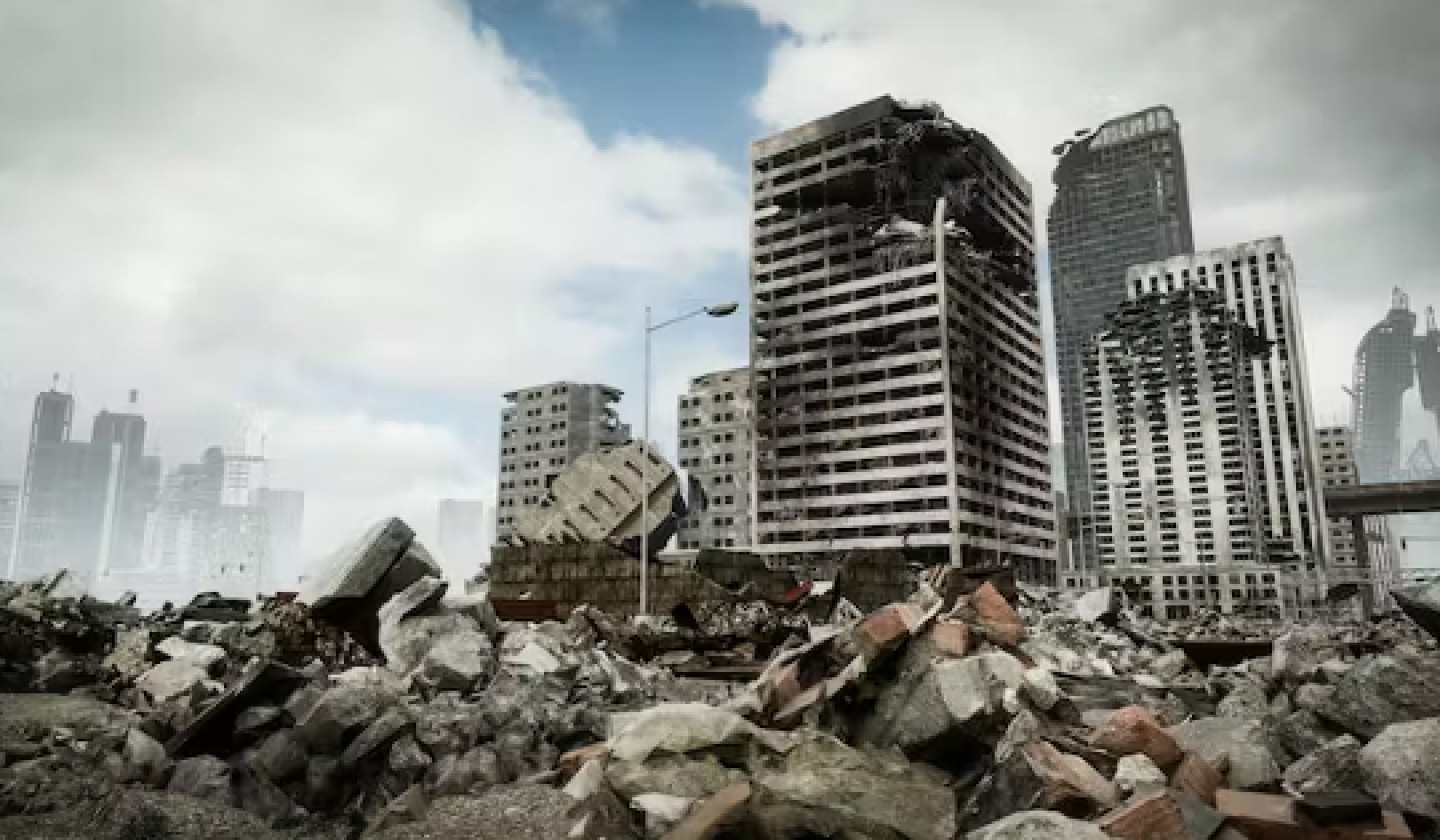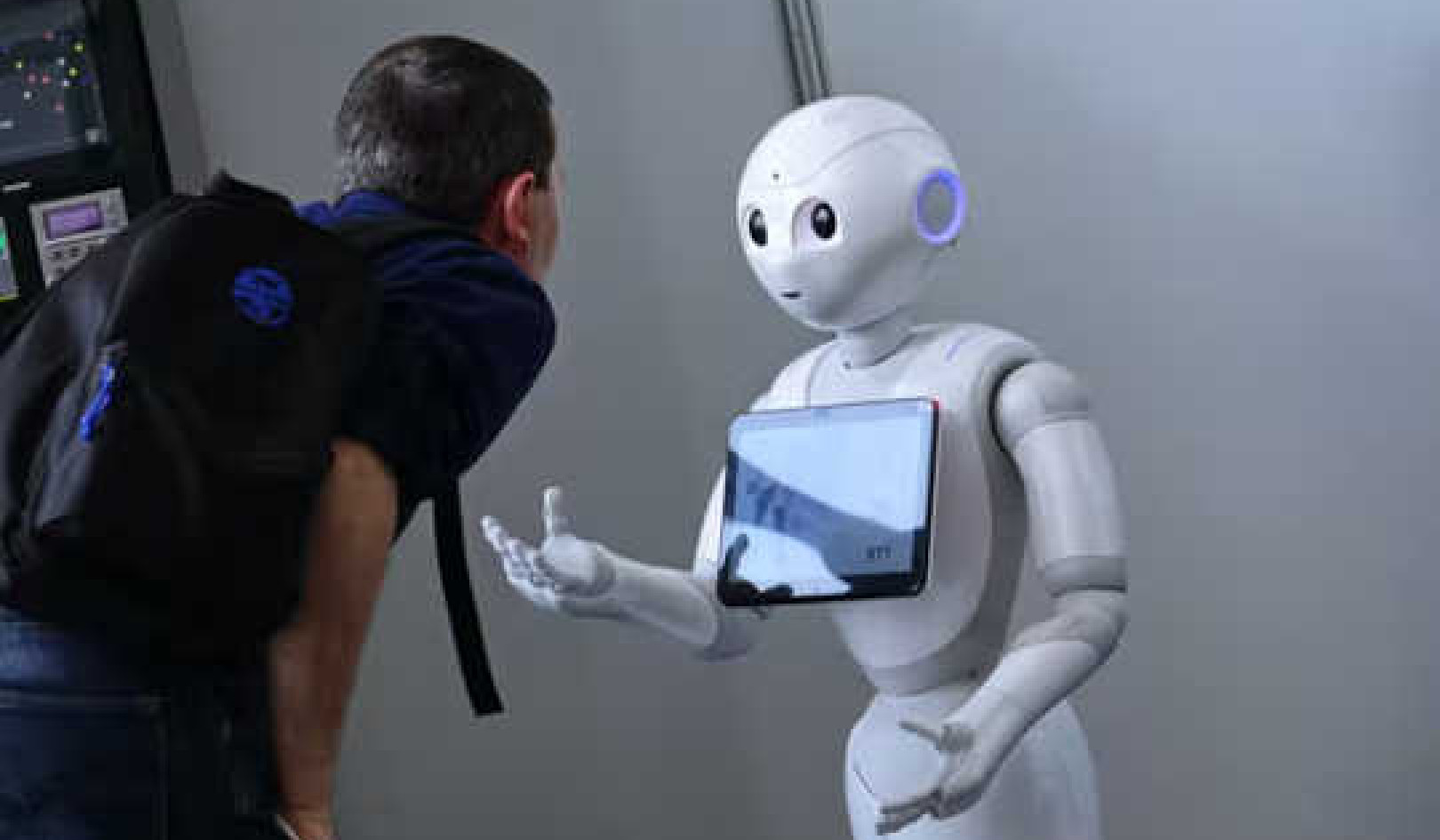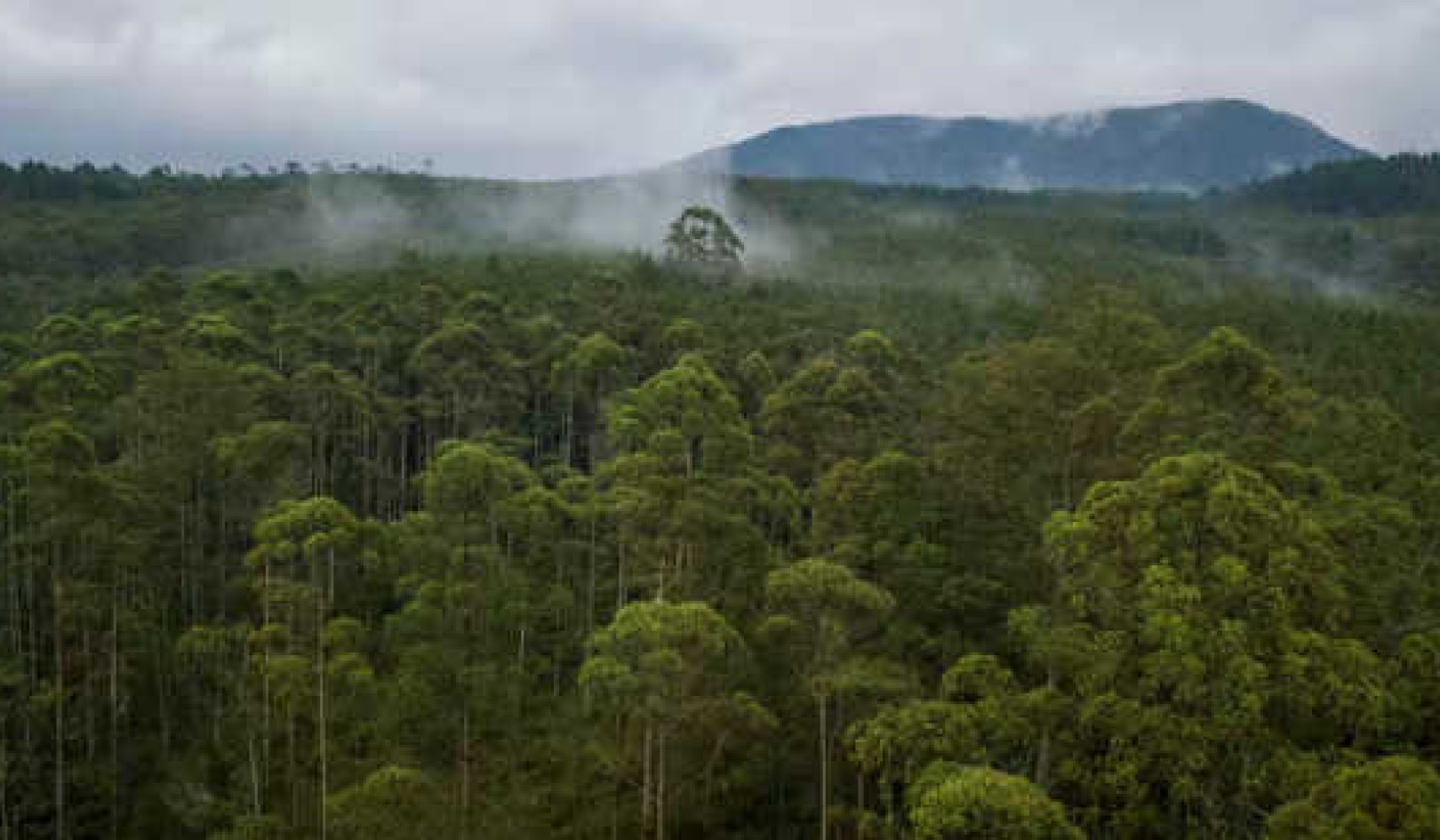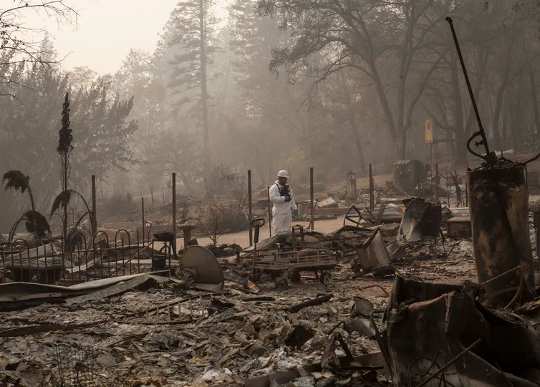 Debris in Paradise, California, after the Camp Fire, Nov. 17, 2018. Senior Airman Crystal Housman/U.S. Air National Guard, CC BY
Debris in Paradise, California, after the Camp Fire, Nov. 17, 2018. Senior Airman Crystal Housman/U.S. Air National Guard, CC BY
Less than halfway through the 2020 wildfire season, fires are burning large swaths of the western U.S. As in previous years, these disasters have entered populated areas, damaging drinking water networks. Water systems have lost pressure, potentially sucking in pollutants, and several utilities are warning of possible and confirmed chemical contamination.
We are environmental engineers who help communities affected by disasters, including support for responses to the 2017 Tubbs Fire and 2018 Camp Fire in California. As we concluded in a recently published study of burned areas, communities need to upgrade building codes to keep wildfires from causing widespread contamination of drinking water systems. They also need to act more aggressively to protect residents from possible toxic exposure immediately after fires.
How wildfires poison water systems
After both the 2017 Tubbs Fire in California’s Sonoma and Napa counties and the 2018 Camp Fire in Butte County, California, drinking water tests revealed a plethora of acutely toxic and carcinogenic pollutants. Water inside homes was not safe to use – or even to treat.
Wildfires in your area may cause power outages and contaminate your drinking water, even if the fire does not actually reach your home. Have emergency provisions in place before a wildfire strikes! #preparedness pic.twitter.com/oT9I9rhzBw
— USFS Fire-California (@R5_Fire_News) October 23, 2019
Water pipes buried underground and inside of buildings were extensively contaminated. Both fires destroyed fire hydrants, water pipes and meter boxes. Leaks and ruptured hydrants were common.
After the fires passed, testing ultimately revealed widespread hazardous drinking water contamination in areas affected by both fires. Evidence suggests that the toxic chemicals originated from a combination of burning vegetation, structures and plastic materials.
Chemicals in the air may have also been sucked into hydrants as water pipes lost pressure. Some water system plastics decomposed and leached chemicals directly into water. Toxic chemicals then spread throughout pipe networks and into buildings.
Limited water testing by state and local agencies showed that benzene and naphthalene were present at levels that could cause immediate physical harm. These chemicals, as well as methylene chloride, styrene, toluene and vinyl chloride, exceeded limits for longer-term exposure.
All of these substances are volatile organic compounds – chemicals that readily evaporate into the air at room temperature. Many of them cause cancer. All can cause vomiting, diarrhea and nausea after a brief high-concentration exposure.
Simply running a cold water faucet can release volatile organic compounds from tap water into the air. Heating water for showers or cooking makes them enter the air even faster, creating a more severe inhalation risk. Some can also be absorbed through the skin.
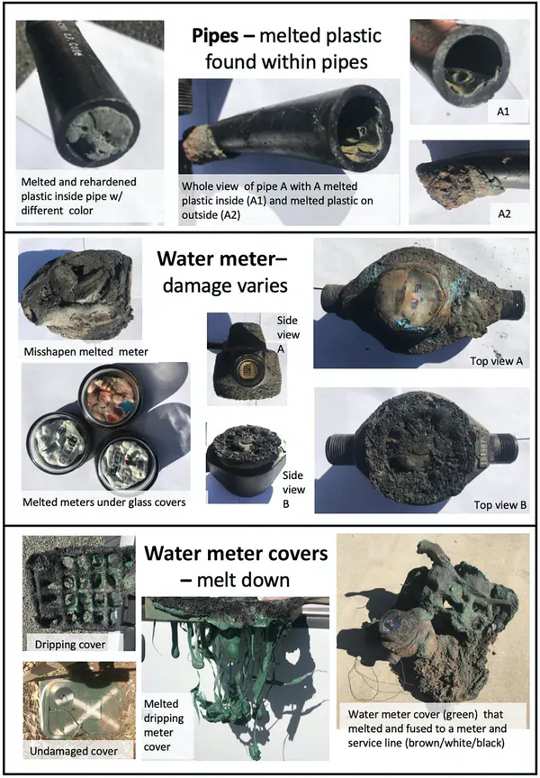 Pipes, water meters and meter covers after wildfires destroyed them. Caitlin Proctor, Amisha Shah, David Yu, and Andrew Whelton/Purdue University, CC BY-ND
Pipes, water meters and meter covers after wildfires destroyed them. Caitlin Proctor, Amisha Shah, David Yu, and Andrew Whelton/Purdue University, CC BY-ND
Protecting the public
In our view, agencies should not underestimate health hazards posed by fire-damaged drinking water systems. Just in the past month, after the CZU Lightning Complex Fire burned parts of San Mateo and Santa Cruz counties, California officials and a water utility issued and reissued an advisory allowing children to bathe in potentially contaminated drinking water. Five days later, when limited test results became available, both organizations recanted and said no one should bathe in the water.
To avoid this kind of error, we recommend issuing “Do Not Use” orders in the wake of major fires to protect the public before water testing results are available. We believe it is acceptable to use water for fire fighting and toilet flushing, but not for purposes that involve ingestion, skin exposure or inhalation, such as bathing or cooking.
Under no circumstance should people be told to smell the water to determine its safety, as officials recommended for months after the Camp Fire. Many harmful chemicals have no odor, so only testing can determine safety.
Advisories to boil water should not be used, since boiling speeds up the release of toxic chemicals into the air. Nor do we recommend “Do Not Drink/Do Not Boil” advisories, which allow bathing in contaminated water.
Before agencies lift or modify advisories, we believe they should be required to carry out thorough chemical screens of water systems. Too often, officials charged with protecting public health fail to take this step, exposing people to needless risk. More typically, they act like California’s San Lorenzo Valley Water District, which lifted a post-wildfire “Do Not Drink/Do Not Boil” order in parts of its territory on Sept. 7, 2020 with a notice to ratepayers that “If test results reveal anything harmful, you will be advised promptly.”
Agencies also need to test buildings for water contamination. Home drinking water quality can differ from room to room, so reliable testing should sample both cold and hot water at many locations within each building.
While infrastructure is being repaired, survivors need a safe water supply. Water treatment devices sold for home use, such as refrigerator and faucet water filters, are not approved for extremely contaminated water, although sales representatives and government officials may mistakenly think the devices can be used for that purpose. While survivors wait for safe water to return, government agencies should ensure that reliable emergency water supplies are available.
Update building codes for future fires
Our research underscores that community building codes are inadequate to prevent wildfire-caused pollution of drinking water and homes.
Adopting codes that require builders to install fire-resistant meter boxes and place them farther from vegetation would help prevent infrastructure from burning so readily in wildfires. Concrete meter boxes and water meters with minimal plastic components would be less likely to ignite. Some plastics may be practically impossible to make safe again, since all types are susceptible to fire and heat.
Installing one-way valves, called backflow prevention devices, at each water meter can prevent contamination rushing out of the damaged building from flowing into the larger buried pipe network. Water main shutoff valves and water sampling taps should exist at every water meter box. Sample taps can help responders quickly determine water safety.
As the past several years have shown, many communities need to be better prepared for wildfires. Two years after the Camp Fire, the town of Paradise, California is still clearing and repairing its water system, at an estimated cost of up to US$150 million. We believe the time to upgrade in other towns is now.
About The Authors
Andrew J. Whelton, Associate Professor of Civil, Environmental & Ecological Engineering, Purdue University and Caitlin R. Proctor, Lillian Gilbreth Postdoctoral Fellow, Purdue University
This article is republished from The Conversation under a Creative Commons license. Read the original article.
Related Books
Life After Carbon: The Next Global Transformation of Cities
by Peter Plastrik , John Cleveland The future of our cities is not what it used to be. The modern-city model that took hold globally in the twentieth century has outlived its usefulness. It cannot solve the problems it helped to create—especially global warming. Fortunately, a new model for urban development is emerging in cities to aggressively tackle the realities of climate change. It transforms the way cities design and use physical space, generate economic wealth, consume and dispose of resources, exploit and sustain the natural ecosystems, and prepare for the future. Available On Amazon
The future of our cities is not what it used to be. The modern-city model that took hold globally in the twentieth century has outlived its usefulness. It cannot solve the problems it helped to create—especially global warming. Fortunately, a new model for urban development is emerging in cities to aggressively tackle the realities of climate change. It transforms the way cities design and use physical space, generate economic wealth, consume and dispose of resources, exploit and sustain the natural ecosystems, and prepare for the future. Available On Amazon
The Sixth Extinction: An Unnatural History
by Elizabeth Kolbert Over the last half-billion years, there have been Five mass extinctions, when the diversity of life on earth suddenly and dramatically contracted. Scientists around the world are currently monitoring the sixth extinction, predicted to be the most devastating extinction event since the asteroid impact that wiped out the dinosaurs. This time around, the cataclysm is us. In prose that is at once frank, entertaining, and deeply informed, New Yorker writer Elizabeth Kolbert tells us why and how human beings have altered life on the planet in a way no species has before. Interweaving research in half a dozen disciplines, descriptions of the fascinating species that have already been lost, and the history of extinction as a concept, Kolbert provides a moving and comprehensive account of the disappearances occurring before our very eyes. She shows that the sixth extinction is likely to be mankind's most lasting legacy, compelling us to rethink the fundamental question of what it means to be human. Available On Amazon
Over the last half-billion years, there have been Five mass extinctions, when the diversity of life on earth suddenly and dramatically contracted. Scientists around the world are currently monitoring the sixth extinction, predicted to be the most devastating extinction event since the asteroid impact that wiped out the dinosaurs. This time around, the cataclysm is us. In prose that is at once frank, entertaining, and deeply informed, New Yorker writer Elizabeth Kolbert tells us why and how human beings have altered life on the planet in a way no species has before. Interweaving research in half a dozen disciplines, descriptions of the fascinating species that have already been lost, and the history of extinction as a concept, Kolbert provides a moving and comprehensive account of the disappearances occurring before our very eyes. She shows that the sixth extinction is likely to be mankind's most lasting legacy, compelling us to rethink the fundamental question of what it means to be human. Available On Amazon
Climate Wars: The Fight for Survival as the World Overheats
by Gwynne Dyer Waves of climate refugees. Dozens of failed states. All-out war. From one of the world’s great geopolitical analysts comes a terrifying glimpse of the strategic realities of the near future, when climate change drives the world’s powers towards the cut-throat politics of survival. Prescient and unflinching, Climate Wars will be one of the most important books of the coming years. Read it and find out what we’re heading for. Available On Amazon
Waves of climate refugees. Dozens of failed states. All-out war. From one of the world’s great geopolitical analysts comes a terrifying glimpse of the strategic realities of the near future, when climate change drives the world’s powers towards the cut-throat politics of survival. Prescient and unflinching, Climate Wars will be one of the most important books of the coming years. Read it and find out what we’re heading for. Available On Amazon
From The Publisher:
Purchases on Amazon go to defray the cost of bringing you InnerSelf.comelf.com, MightyNatural.com, and ClimateImpactNews.com at no cost and without advertisers that track your browsing habits. Even if you click on a link but don't buy these selected products, anything else you buy in that same visit on Amazon pays us a small commission. There is no additional cost to you, so please contribute to the effort. You can also use this link to use to Amazon at any time so you can help support our efforts.


















